Taxation Law: Fringe Benefits and Capital Gains Tax
VerifiedAdded on 2023/06/08
|13
|3637
|210
AI Summary
This article discusses the rulings and regulations related to fringe benefits and capital gains tax in taxation law. It covers topics such as car fringe benefits, car parking fringe benefits, FB loans, and capital gains tax events.
Contribute Materials
Your contribution can guide someone’s learning journey. Share your
documents today.
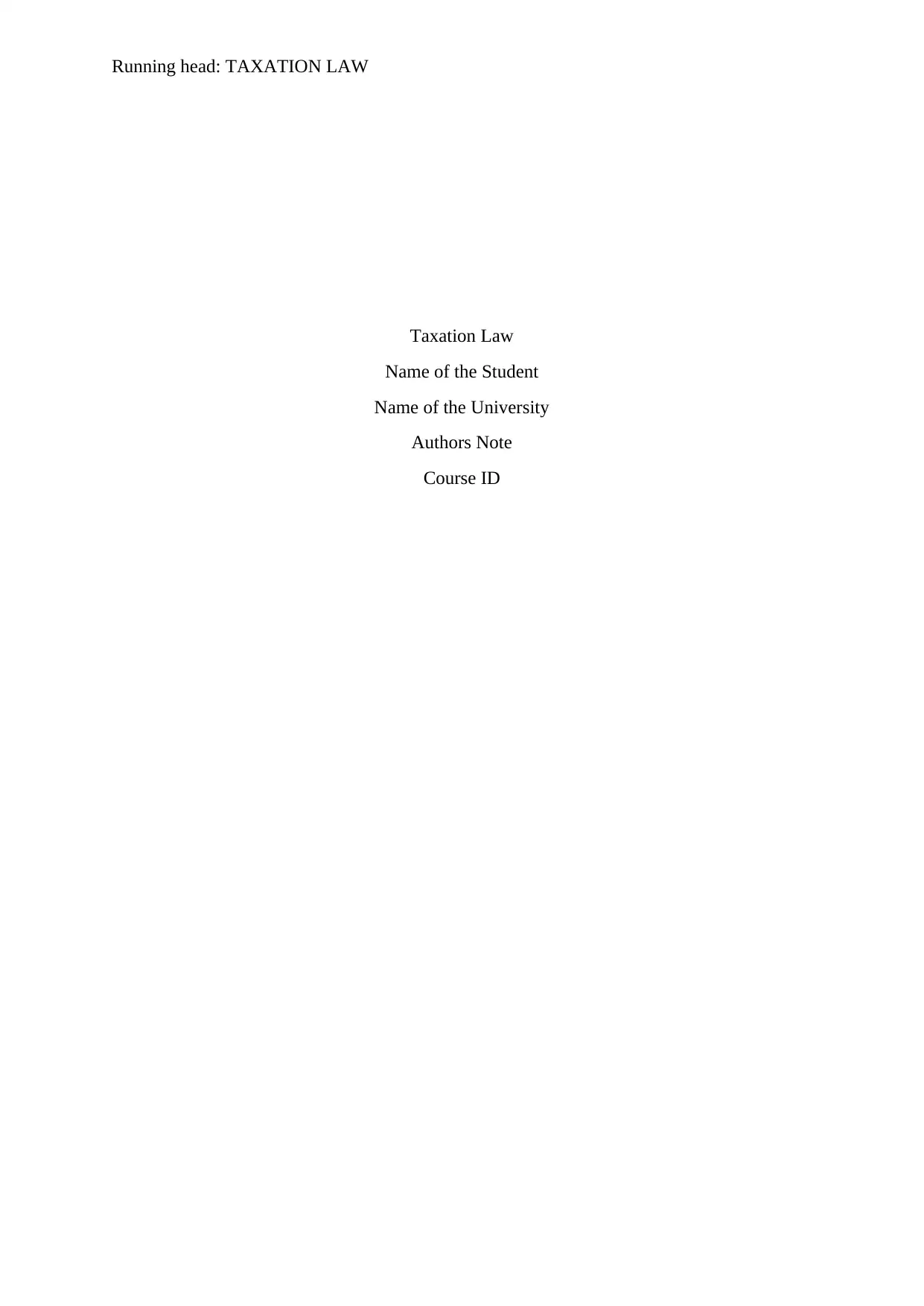
Running head: TAXATION LAW
Taxation Law
Name of the Student
Name of the University
Authors Note
Course ID
Taxation Law
Name of the Student
Name of the University
Authors Note
Course ID
Secure Best Marks with AI Grader
Need help grading? Try our AI Grader for instant feedback on your assignments.
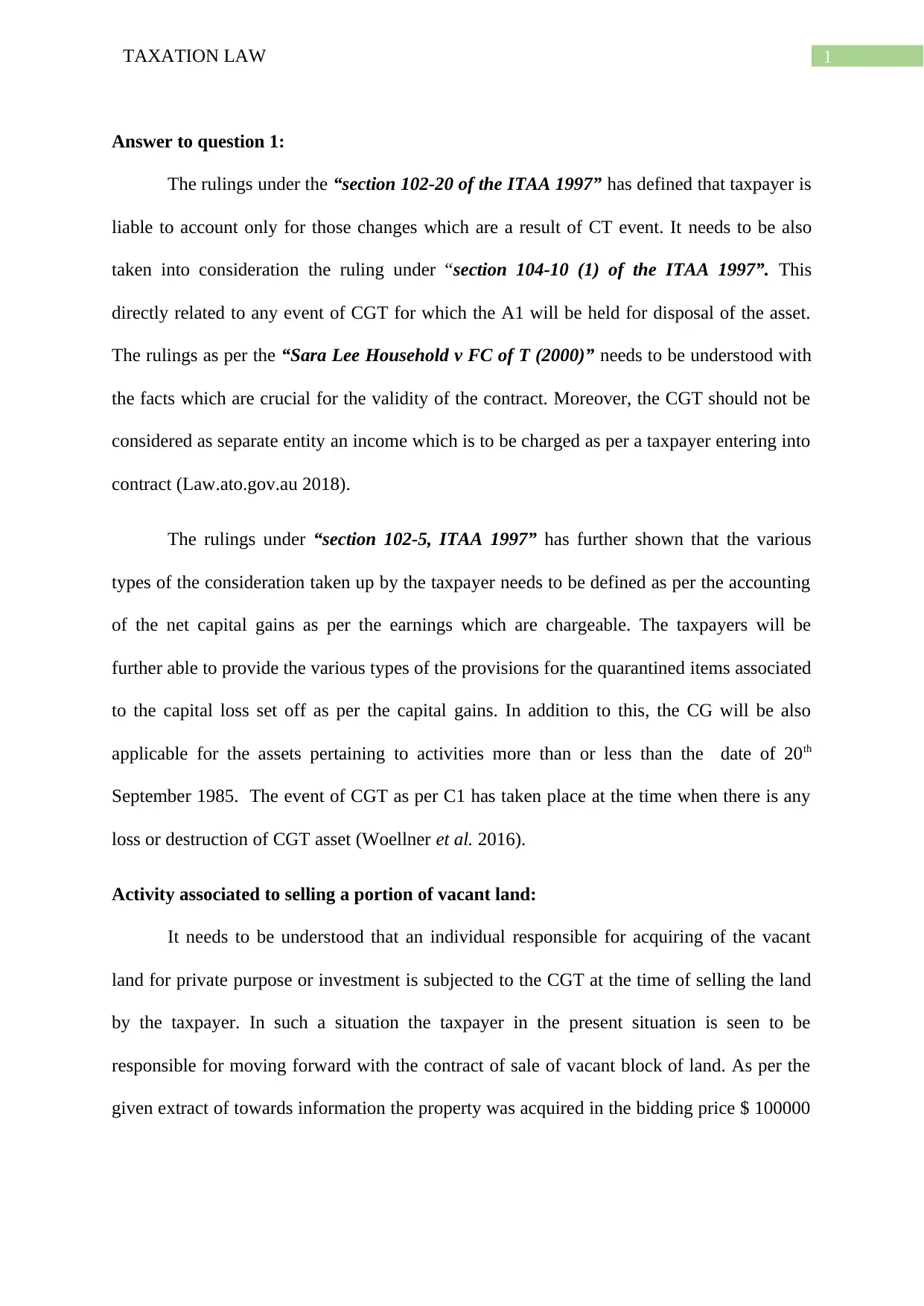
1TAXATION LAW
Answer to question 1:
The rulings under the “section 102-20 of the ITAA 1997” has defined that taxpayer is
liable to account only for those changes which are a result of CT event. It needs to be also
taken into consideration the ruling under “section 104-10 (1) of the ITAA 1997”. This
directly related to any event of CGT for which the A1 will be held for disposal of the asset.
The rulings as per the “Sara Lee Household v FC of T (2000)” needs to be understood with
the facts which are crucial for the validity of the contract. Moreover, the CGT should not be
considered as separate entity an income which is to be charged as per a taxpayer entering into
contract (Law.ato.gov.au 2018).
The rulings under “section 102-5, ITAA 1997” has further shown that the various
types of the consideration taken up by the taxpayer needs to be defined as per the accounting
of the net capital gains as per the earnings which are chargeable. The taxpayers will be
further able to provide the various types of the provisions for the quarantined items associated
to the capital loss set off as per the capital gains. In addition to this, the CG will be also
applicable for the assets pertaining to activities more than or less than the date of 20th
September 1985. The event of CGT as per C1 has taken place at the time when there is any
loss or destruction of CGT asset (Woellner et al. 2016).
Activity associated to selling a portion of vacant land:
It needs to be understood that an individual responsible for acquiring of the vacant
land for private purpose or investment is subjected to the CGT at the time of selling the land
by the taxpayer. In such a situation the taxpayer in the present situation is seen to be
responsible for moving forward with the contract of sale of vacant block of land. As per the
given extract of towards information the property was acquired in the bidding price $ 100000
Answer to question 1:
The rulings under the “section 102-20 of the ITAA 1997” has defined that taxpayer is
liable to account only for those changes which are a result of CT event. It needs to be also
taken into consideration the ruling under “section 104-10 (1) of the ITAA 1997”. This
directly related to any event of CGT for which the A1 will be held for disposal of the asset.
The rulings as per the “Sara Lee Household v FC of T (2000)” needs to be understood with
the facts which are crucial for the validity of the contract. Moreover, the CGT should not be
considered as separate entity an income which is to be charged as per a taxpayer entering into
contract (Law.ato.gov.au 2018).
The rulings under “section 102-5, ITAA 1997” has further shown that the various
types of the consideration taken up by the taxpayer needs to be defined as per the accounting
of the net capital gains as per the earnings which are chargeable. The taxpayers will be
further able to provide the various types of the provisions for the quarantined items associated
to the capital loss set off as per the capital gains. In addition to this, the CG will be also
applicable for the assets pertaining to activities more than or less than the date of 20th
September 1985. The event of CGT as per C1 has taken place at the time when there is any
loss or destruction of CGT asset (Woellner et al. 2016).
Activity associated to selling a portion of vacant land:
It needs to be understood that an individual responsible for acquiring of the vacant
land for private purpose or investment is subjected to the CGT at the time of selling the land
by the taxpayer. In such a situation the taxpayer in the present situation is seen to be
responsible for moving forward with the contract of sale of vacant block of land. As per the
given extract of towards information the property was acquired in the bidding price $ 100000

2TAXATION LAW
with an $ 20,000 pertaining to local council for the land tax and water during the period of
ownership (Braithwaite 2017).
As per the explanation of the ATO, the unoccupied property in possession of the tax
payer needs to subjected for the CGT similar to other properties. In addition to this, the ATO
will also require to record the cost and date of the acquisition land. This depicted to be
inclusive of the interest on loan and council rates (Tan, Braithwaite and Reinhart 2016).
In the present aspect the taxpayer’s expenses are seen with the expenses pertaining to
the local council along with tax on land and water. The taxpayers need to be also cautious
during the claiming of the deductions pertaining to the IT purpose as the there was no
instance of revenue generated from the land. Instead of this, the taxpayer will be able to
consider the local expenses for water and sewage in the cost base of property as this will help
in the computation of the net CGT at the time land was sold (Middleton 2015).
Antique Bed:
The definition of as per the “section 108-10(2) of the ITAA 1997”. “Section 108-
10(1), ITAA 1997” have detailed about quarantining about the items which apples to the
items under CL. As stated in the “section 108-10(2), ITAA 1997” the collectibles refer to
postage stamp, rarer portfolios and manuscript. There are also few items which are needed to
be included for the personal usage of the taxpayers. There are also certain rules which are
applicable for the collectables (Ali et al. 2017).
Moreover, as collectibles are worth less than $ 500, the CL and CG are taken into
account with the cost and time consideration. This amendment suggests that the taxpayer’s
antique bed was stolen from his place of abode. Despite of this, insurance companies have
stated that the antique bed was not any specific item but the insurance policy itself. This
with an $ 20,000 pertaining to local council for the land tax and water during the period of
ownership (Braithwaite 2017).
As per the explanation of the ATO, the unoccupied property in possession of the tax
payer needs to subjected for the CGT similar to other properties. In addition to this, the ATO
will also require to record the cost and date of the acquisition land. This depicted to be
inclusive of the interest on loan and council rates (Tan, Braithwaite and Reinhart 2016).
In the present aspect the taxpayer’s expenses are seen with the expenses pertaining to
the local council along with tax on land and water. The taxpayers need to be also cautious
during the claiming of the deductions pertaining to the IT purpose as the there was no
instance of revenue generated from the land. Instead of this, the taxpayer will be able to
consider the local expenses for water and sewage in the cost base of property as this will help
in the computation of the net CGT at the time land was sold (Middleton 2015).
Antique Bed:
The definition of as per the “section 108-10(2) of the ITAA 1997”. “Section 108-
10(1), ITAA 1997” have detailed about quarantining about the items which apples to the
items under CL. As stated in the “section 108-10(2), ITAA 1997” the collectibles refer to
postage stamp, rarer portfolios and manuscript. There are also few items which are needed to
be included for the personal usage of the taxpayers. There are also certain rules which are
applicable for the collectables (Ali et al. 2017).
Moreover, as collectibles are worth less than $ 500, the CL and CG are taken into
account with the cost and time consideration. This amendment suggests that the taxpayer’s
antique bed was stolen from his place of abode. Despite of this, insurance companies have
stated that the antique bed was not any specific item but the insurance policy itself. This
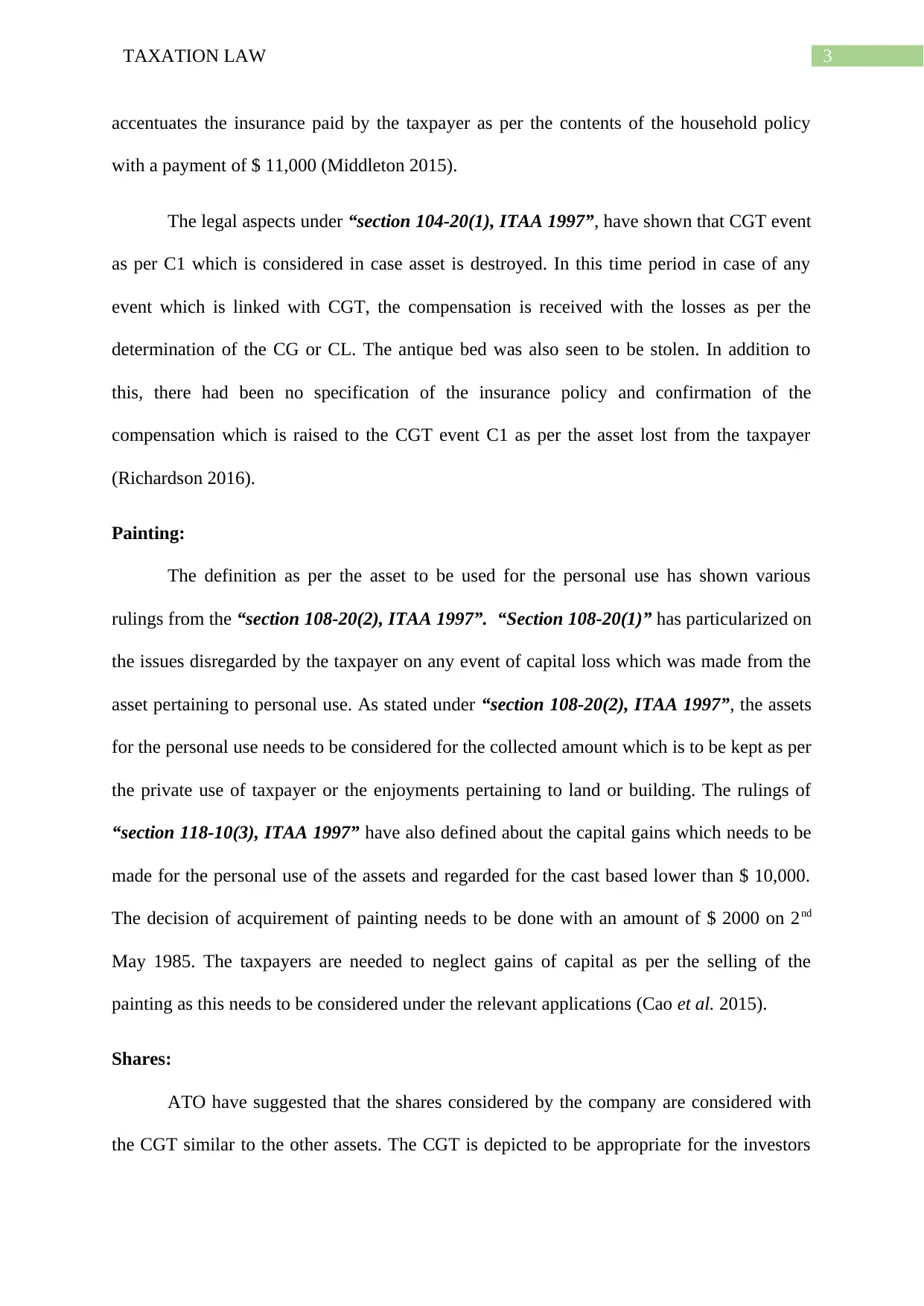
3TAXATION LAW
accentuates the insurance paid by the taxpayer as per the contents of the household policy
with a payment of $ 11,000 (Middleton 2015).
The legal aspects under “section 104-20(1), ITAA 1997”, have shown that CGT event
as per C1 which is considered in case asset is destroyed. In this time period in case of any
event which is linked with CGT, the compensation is received with the losses as per the
determination of the CG or CL. The antique bed was also seen to be stolen. In addition to
this, there had been no specification of the insurance policy and confirmation of the
compensation which is raised to the CGT event C1 as per the asset lost from the taxpayer
(Richardson 2016).
Painting:
The definition as per the asset to be used for the personal use has shown various
rulings from the “section 108-20(2), ITAA 1997”. “Section 108-20(1)” has particularized on
the issues disregarded by the taxpayer on any event of capital loss which was made from the
asset pertaining to personal use. As stated under “section 108-20(2), ITAA 1997”, the assets
for the personal use needs to be considered for the collected amount which is to be kept as per
the private use of taxpayer or the enjoyments pertaining to land or building. The rulings of
“section 118-10(3), ITAA 1997” have also defined about the capital gains which needs to be
made for the personal use of the assets and regarded for the cast based lower than $ 10,000.
The decision of acquirement of painting needs to be done with an amount of $ 2000 on 2nd
May 1985. The taxpayers are needed to neglect gains of capital as per the selling of the
painting as this needs to be considered under the relevant applications (Cao et al. 2015).
Shares:
ATO have suggested that the shares considered by the company are considered with
the CGT similar to the other assets. The CGT is depicted to be appropriate for the investors
accentuates the insurance paid by the taxpayer as per the contents of the household policy
with a payment of $ 11,000 (Middleton 2015).
The legal aspects under “section 104-20(1), ITAA 1997”, have shown that CGT event
as per C1 which is considered in case asset is destroyed. In this time period in case of any
event which is linked with CGT, the compensation is received with the losses as per the
determination of the CG or CL. The antique bed was also seen to be stolen. In addition to
this, there had been no specification of the insurance policy and confirmation of the
compensation which is raised to the CGT event C1 as per the asset lost from the taxpayer
(Richardson 2016).
Painting:
The definition as per the asset to be used for the personal use has shown various
rulings from the “section 108-20(2), ITAA 1997”. “Section 108-20(1)” has particularized on
the issues disregarded by the taxpayer on any event of capital loss which was made from the
asset pertaining to personal use. As stated under “section 108-20(2), ITAA 1997”, the assets
for the personal use needs to be considered for the collected amount which is to be kept as per
the private use of taxpayer or the enjoyments pertaining to land or building. The rulings of
“section 118-10(3), ITAA 1997” have also defined about the capital gains which needs to be
made for the personal use of the assets and regarded for the cast based lower than $ 10,000.
The decision of acquirement of painting needs to be done with an amount of $ 2000 on 2nd
May 1985. The taxpayers are needed to neglect gains of capital as per the selling of the
painting as this needs to be considered under the relevant applications (Cao et al. 2015).
Shares:
ATO have suggested that the shares considered by the company are considered with
the CGT similar to the other assets. The CGT is depicted to be appropriate for the investors
Paraphrase This Document
Need a fresh take? Get an instant paraphrase of this document with our AI Paraphraser
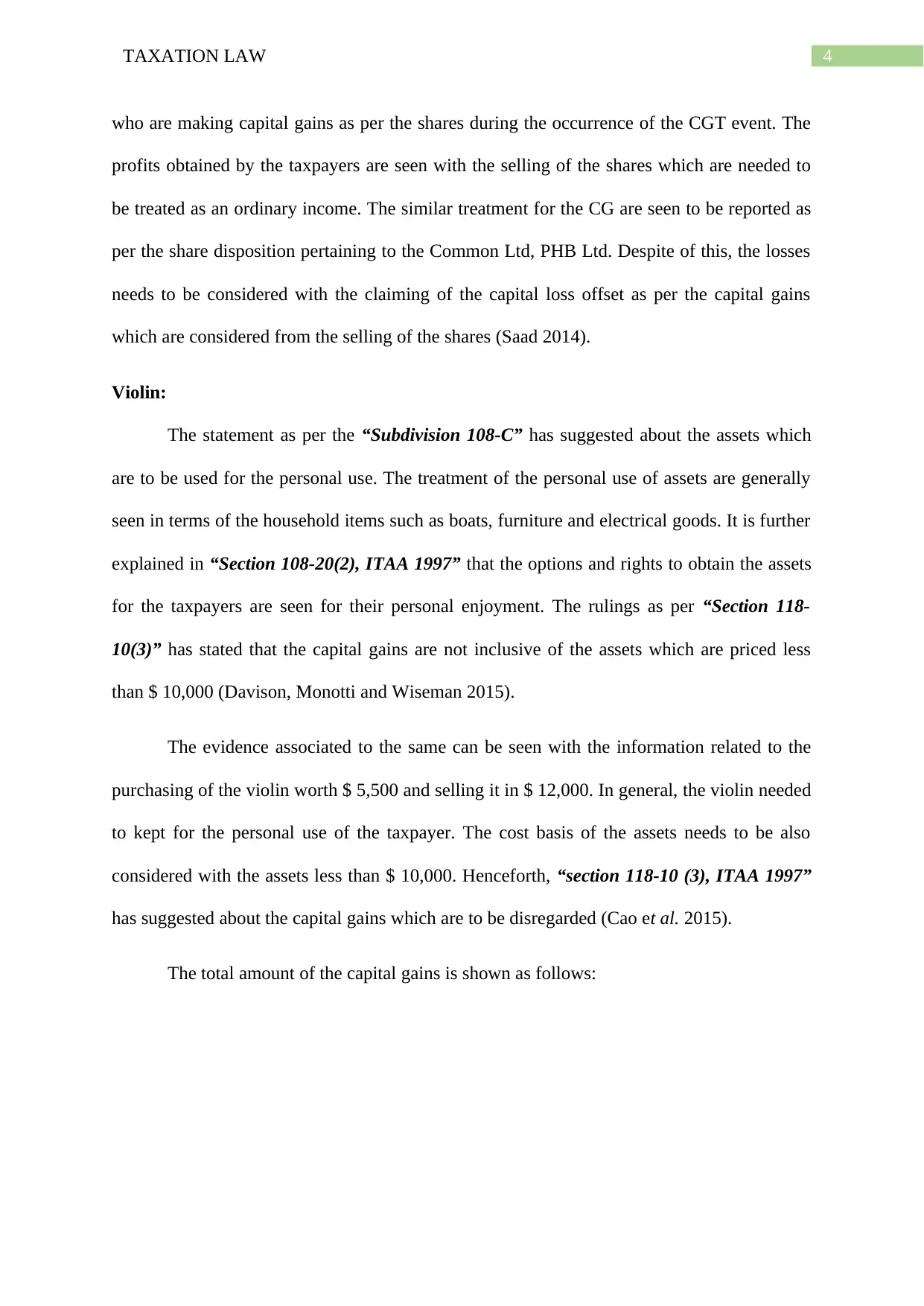
4TAXATION LAW
who are making capital gains as per the shares during the occurrence of the CGT event. The
profits obtained by the taxpayers are seen with the selling of the shares which are needed to
be treated as an ordinary income. The similar treatment for the CG are seen to be reported as
per the share disposition pertaining to the Common Ltd, PHB Ltd. Despite of this, the losses
needs to be considered with the claiming of the capital loss offset as per the capital gains
which are considered from the selling of the shares (Saad 2014).
Violin:
The statement as per the “Subdivision 108-C” has suggested about the assets which
are to be used for the personal use. The treatment of the personal use of assets are generally
seen in terms of the household items such as boats, furniture and electrical goods. It is further
explained in “Section 108-20(2), ITAA 1997” that the options and rights to obtain the assets
for the taxpayers are seen for their personal enjoyment. The rulings as per “Section 118-
10(3)” has stated that the capital gains are not inclusive of the assets which are priced less
than $ 10,000 (Davison, Monotti and Wiseman 2015).
The evidence associated to the same can be seen with the information related to the
purchasing of the violin worth $ 5,500 and selling it in $ 12,000. In general, the violin needed
to kept for the personal use of the taxpayer. The cost basis of the assets needs to be also
considered with the assets less than $ 10,000. Henceforth, “section 118-10 (3), ITAA 1997”
has suggested about the capital gains which are to be disregarded (Cao et al. 2015).
The total amount of the capital gains is shown as follows:
who are making capital gains as per the shares during the occurrence of the CGT event. The
profits obtained by the taxpayers are seen with the selling of the shares which are needed to
be treated as an ordinary income. The similar treatment for the CG are seen to be reported as
per the share disposition pertaining to the Common Ltd, PHB Ltd. Despite of this, the losses
needs to be considered with the claiming of the capital loss offset as per the capital gains
which are considered from the selling of the shares (Saad 2014).
Violin:
The statement as per the “Subdivision 108-C” has suggested about the assets which
are to be used for the personal use. The treatment of the personal use of assets are generally
seen in terms of the household items such as boats, furniture and electrical goods. It is further
explained in “Section 108-20(2), ITAA 1997” that the options and rights to obtain the assets
for the taxpayers are seen for their personal enjoyment. The rulings as per “Section 118-
10(3)” has stated that the capital gains are not inclusive of the assets which are priced less
than $ 10,000 (Davison, Monotti and Wiseman 2015).
The evidence associated to the same can be seen with the information related to the
purchasing of the violin worth $ 5,500 and selling it in $ 12,000. In general, the violin needed
to kept for the personal use of the taxpayer. The cost basis of the assets needs to be also
considered with the assets less than $ 10,000. Henceforth, “section 118-10 (3), ITAA 1997”
has suggested about the capital gains which are to be disregarded (Cao et al. 2015).
The total amount of the capital gains is shown as follows:
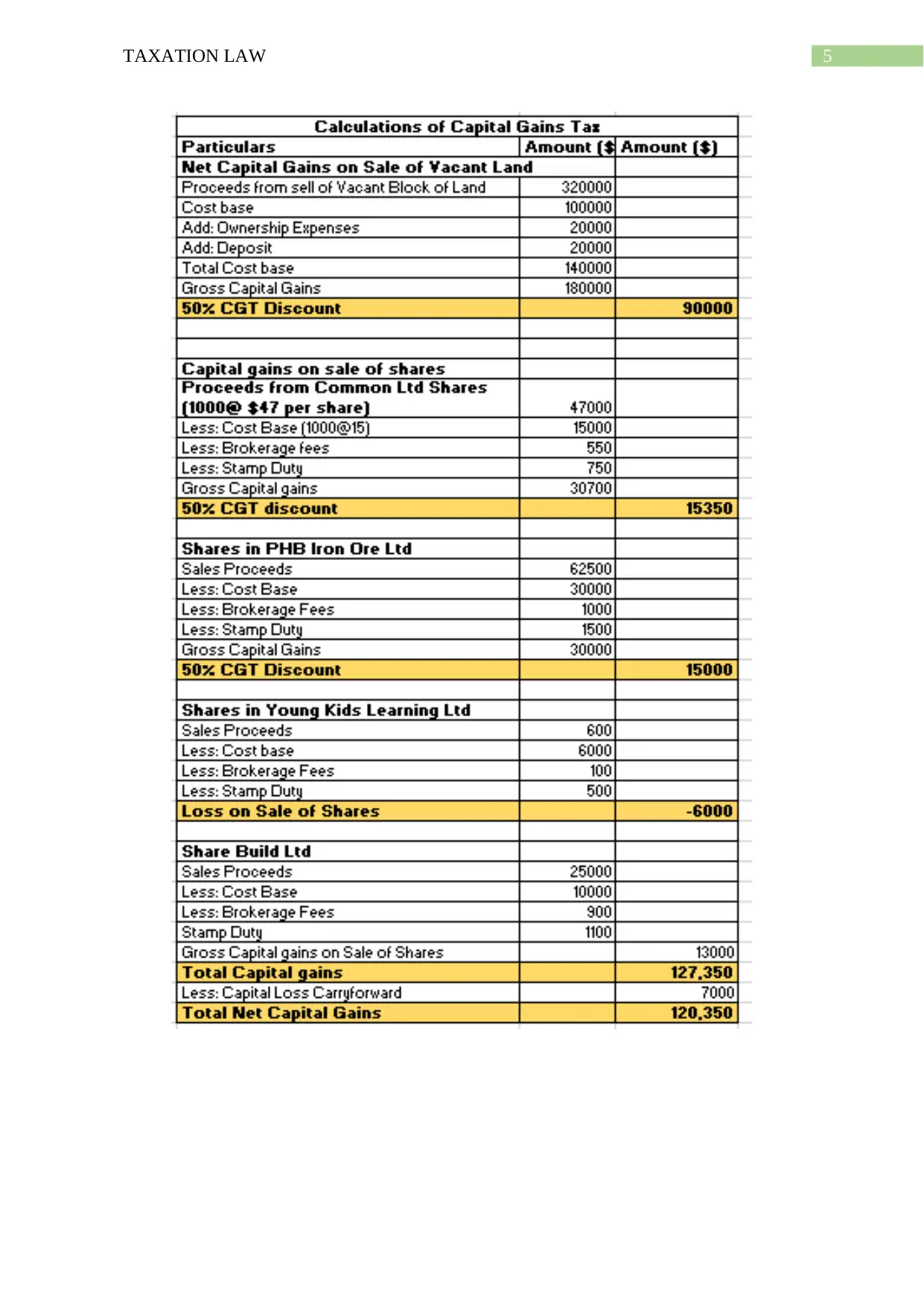
5TAXATION LAW

6TAXATION LAW
Answer to question 2:
Answer to A:
Issues:
The present problems for the evaluation of the FBT repercussions should be
considered as per the rulings stated with “FBTAA 1986”. The problems with determination is
depicted as per the private reason constituting of the fringe benefit as per the “section 7,
FBTAA 1986”. The “section 39 A, FBTAA 1986” is applicable for the taxpayers who can be
held liable for the different types of the expenses pertaining to car parking. The issue needs to
be discussed by considering the fringe benefit as per “subdivision A of FBTAA, 1986”.
Rule:
The rulings as per the fringe benefit is seen where a payment associated to the
employee will form a part of the wages and salary. The legislation as per the fringe benefit
tax comprises of the benefits which is provided to the employees as per the employment. This
is implied as per the benefit which is given to an individual employee.
The law as per “section 7, FBTAA 1986” states that the fringe benefit during the day
is considered as per the employment of the employee. The benefit of the fringe benefit is
mainly constituted of the perks as per the employment of the employees. In the given case car
is regarded as the main form of the fringe benefit which is facilitated by the employer to the
employee. The advantages related to the car fringe benefits needs to be also regarded with the
availability of the fringe benefits which are in relation to the benefits to their employment
(Burton and Karlinsky 2016).
The “sub-section 136 (1), FBTAA 1986” shows that the car held by the employee are
die to the fact of employment therefore usage of the car will be held as per FBT. The usage of
the vehicle by the employee is not to be seen with the direction of gaining assessable income
Answer to question 2:
Answer to A:
Issues:
The present problems for the evaluation of the FBT repercussions should be
considered as per the rulings stated with “FBTAA 1986”. The problems with determination is
depicted as per the private reason constituting of the fringe benefit as per the “section 7,
FBTAA 1986”. The “section 39 A, FBTAA 1986” is applicable for the taxpayers who can be
held liable for the different types of the expenses pertaining to car parking. The issue needs to
be discussed by considering the fringe benefit as per “subdivision A of FBTAA, 1986”.
Rule:
The rulings as per the fringe benefit is seen where a payment associated to the
employee will form a part of the wages and salary. The legislation as per the fringe benefit
tax comprises of the benefits which is provided to the employees as per the employment. This
is implied as per the benefit which is given to an individual employee.
The law as per “section 7, FBTAA 1986” states that the fringe benefit during the day
is considered as per the employment of the employee. The benefit of the fringe benefit is
mainly constituted of the perks as per the employment of the employees. In the given case car
is regarded as the main form of the fringe benefit which is facilitated by the employer to the
employee. The advantages related to the car fringe benefits needs to be also regarded with the
availability of the fringe benefits which are in relation to the benefits to their employment
(Burton and Karlinsky 2016).
The “sub-section 136 (1), FBTAA 1986” shows that the car held by the employee are
die to the fact of employment therefore usage of the car will be held as per FBT. The usage of
the vehicle by the employee is not to be seen with the direction of gaining assessable income
Secure Best Marks with AI Grader
Need help grading? Try our AI Grader for instant feedback on your assignments.
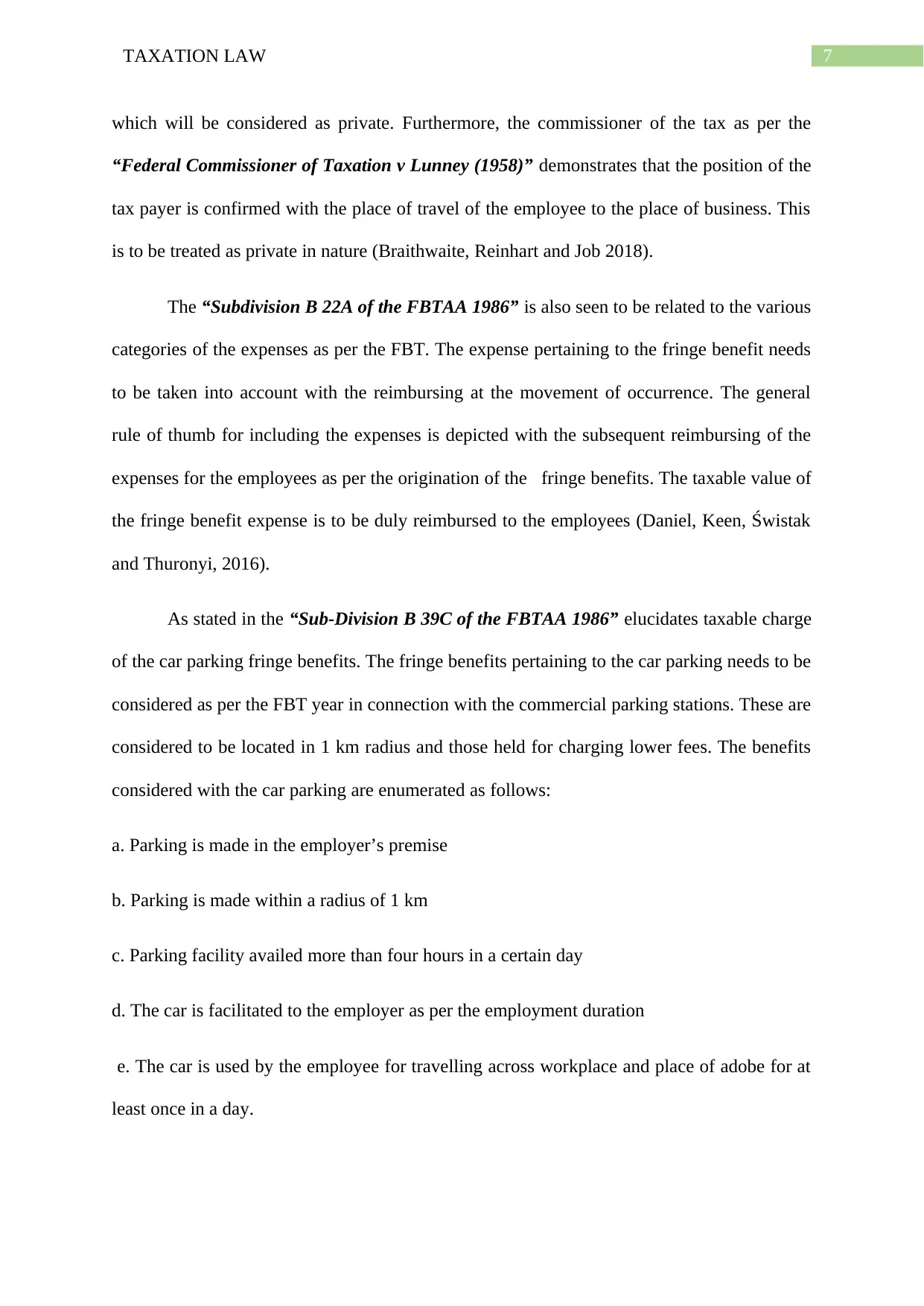
7TAXATION LAW
which will be considered as private. Furthermore, the commissioner of the tax as per the
“Federal Commissioner of Taxation v Lunney (1958)” demonstrates that the position of the
tax payer is confirmed with the place of travel of the employee to the place of business. This
is to be treated as private in nature (Braithwaite, Reinhart and Job 2018).
The “Subdivision B 22A of the FBTAA 1986” is also seen to be related to the various
categories of the expenses as per the FBT. The expense pertaining to the fringe benefit needs
to be taken into account with the reimbursing at the movement of occurrence. The general
rule of thumb for including the expenses is depicted with the subsequent reimbursing of the
expenses for the employees as per the origination of the fringe benefits. The taxable value of
the fringe benefit expense is to be duly reimbursed to the employees (Daniel, Keen, Świstak
and Thuronyi, 2016).
As stated in the “Sub-Division B 39C of the FBTAA 1986” elucidates taxable charge
of the car parking fringe benefits. The fringe benefits pertaining to the car parking needs to be
considered as per the FBT year in connection with the commercial parking stations. These are
considered to be located in 1 km radius and those held for charging lower fees. The benefits
considered with the car parking are enumerated as follows:
a. Parking is made in the employer’s premise
b. Parking is made within a radius of 1 km
c. Parking facility availed more than four hours in a certain day
d. The car is facilitated to the employer as per the employment duration
e. The car is used by the employee for travelling across workplace and place of adobe for at
least once in a day.
which will be considered as private. Furthermore, the commissioner of the tax as per the
“Federal Commissioner of Taxation v Lunney (1958)” demonstrates that the position of the
tax payer is confirmed with the place of travel of the employee to the place of business. This
is to be treated as private in nature (Braithwaite, Reinhart and Job 2018).
The “Subdivision B 22A of the FBTAA 1986” is also seen to be related to the various
categories of the expenses as per the FBT. The expense pertaining to the fringe benefit needs
to be taken into account with the reimbursing at the movement of occurrence. The general
rule of thumb for including the expenses is depicted with the subsequent reimbursing of the
expenses for the employees as per the origination of the fringe benefits. The taxable value of
the fringe benefit expense is to be duly reimbursed to the employees (Daniel, Keen, Świstak
and Thuronyi, 2016).
As stated in the “Sub-Division B 39C of the FBTAA 1986” elucidates taxable charge
of the car parking fringe benefits. The fringe benefits pertaining to the car parking needs to be
considered as per the FBT year in connection with the commercial parking stations. These are
considered to be located in 1 km radius and those held for charging lower fees. The benefits
considered with the car parking are enumerated as follows:
a. Parking is made in the employer’s premise
b. Parking is made within a radius of 1 km
c. Parking facility availed more than four hours in a certain day
d. The car is facilitated to the employer as per the employment duration
e. The car is used by the employee for travelling across workplace and place of adobe for at
least once in a day.
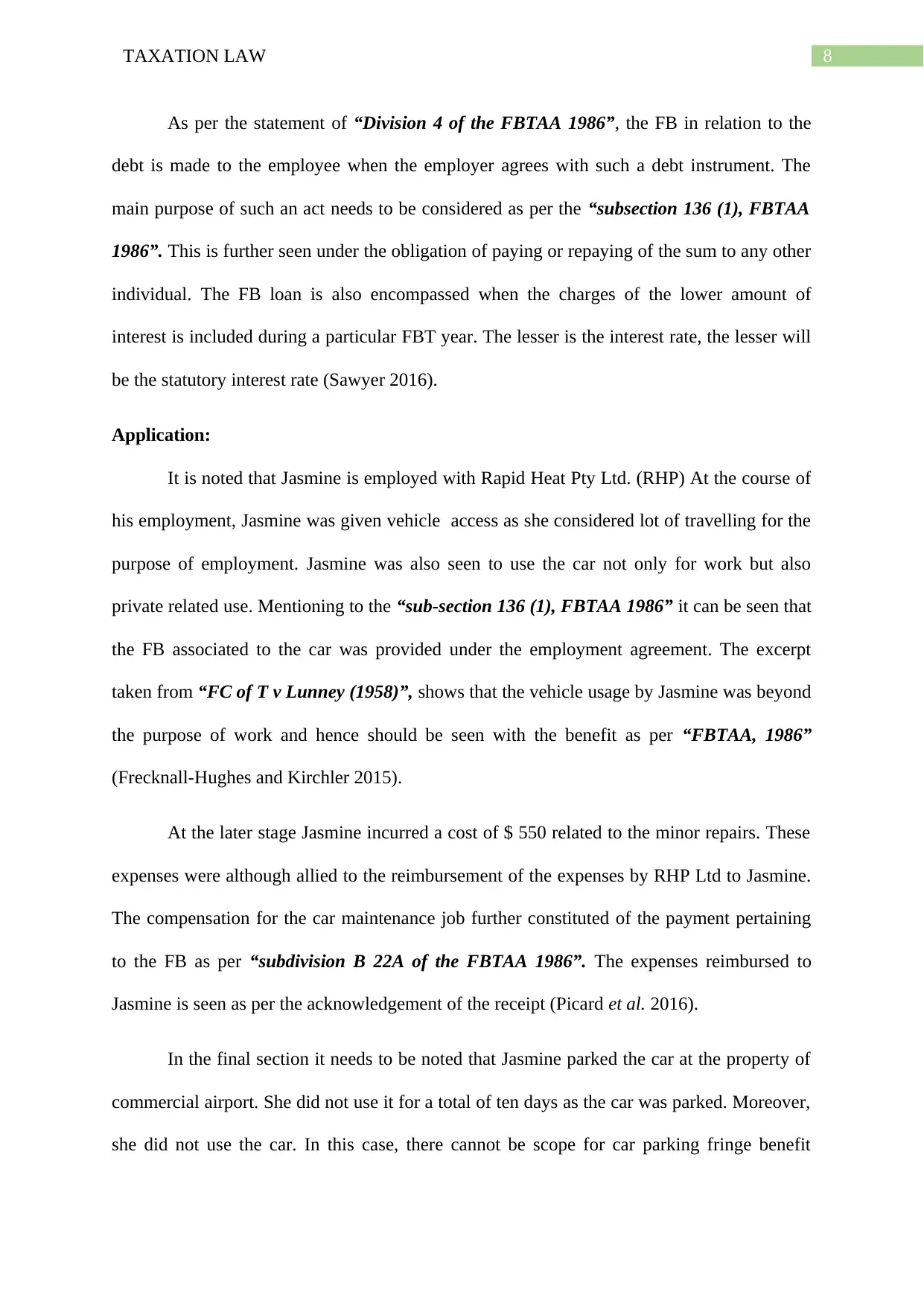
8TAXATION LAW
As per the statement of “Division 4 of the FBTAA 1986”, the FB in relation to the
debt is made to the employee when the employer agrees with such a debt instrument. The
main purpose of such an act needs to be considered as per the “subsection 136 (1), FBTAA
1986”. This is further seen under the obligation of paying or repaying of the sum to any other
individual. The FB loan is also encompassed when the charges of the lower amount of
interest is included during a particular FBT year. The lesser is the interest rate, the lesser will
be the statutory interest rate (Sawyer 2016).
Application:
It is noted that Jasmine is employed with Rapid Heat Pty Ltd. (RHP) At the course of
his employment, Jasmine was given vehicle access as she considered lot of travelling for the
purpose of employment. Jasmine was also seen to use the car not only for work but also
private related use. Mentioning to the “sub-section 136 (1), FBTAA 1986” it can be seen that
the FB associated to the car was provided under the employment agreement. The excerpt
taken from “FC of T v Lunney (1958)”, shows that the vehicle usage by Jasmine was beyond
the purpose of work and hence should be seen with the benefit as per “FBTAA, 1986”
(Frecknall-Hughes and Kirchler 2015).
At the later stage Jasmine incurred a cost of $ 550 related to the minor repairs. These
expenses were although allied to the reimbursement of the expenses by RHP Ltd to Jasmine.
The compensation for the car maintenance job further constituted of the payment pertaining
to the FB as per “subdivision B 22A of the FBTAA 1986”. The expenses reimbursed to
Jasmine is seen as per the acknowledgement of the receipt (Picard et al. 2016).
In the final section it needs to be noted that Jasmine parked the car at the property of
commercial airport. She did not use it for a total of ten days as the car was parked. Moreover,
she did not use the car. In this case, there cannot be scope for car parking fringe benefit
As per the statement of “Division 4 of the FBTAA 1986”, the FB in relation to the
debt is made to the employee when the employer agrees with such a debt instrument. The
main purpose of such an act needs to be considered as per the “subsection 136 (1), FBTAA
1986”. This is further seen under the obligation of paying or repaying of the sum to any other
individual. The FB loan is also encompassed when the charges of the lower amount of
interest is included during a particular FBT year. The lesser is the interest rate, the lesser will
be the statutory interest rate (Sawyer 2016).
Application:
It is noted that Jasmine is employed with Rapid Heat Pty Ltd. (RHP) At the course of
his employment, Jasmine was given vehicle access as she considered lot of travelling for the
purpose of employment. Jasmine was also seen to use the car not only for work but also
private related use. Mentioning to the “sub-section 136 (1), FBTAA 1986” it can be seen that
the FB associated to the car was provided under the employment agreement. The excerpt
taken from “FC of T v Lunney (1958)”, shows that the vehicle usage by Jasmine was beyond
the purpose of work and hence should be seen with the benefit as per “FBTAA, 1986”
(Frecknall-Hughes and Kirchler 2015).
At the later stage Jasmine incurred a cost of $ 550 related to the minor repairs. These
expenses were although allied to the reimbursement of the expenses by RHP Ltd to Jasmine.
The compensation for the car maintenance job further constituted of the payment pertaining
to the FB as per “subdivision B 22A of the FBTAA 1986”. The expenses reimbursed to
Jasmine is seen as per the acknowledgement of the receipt (Picard et al. 2016).
In the final section it needs to be noted that Jasmine parked the car at the property of
commercial airport. She did not use it for a total of ten days as the car was parked. Moreover,
she did not use the car. In this case, there cannot be scope for car parking fringe benefit
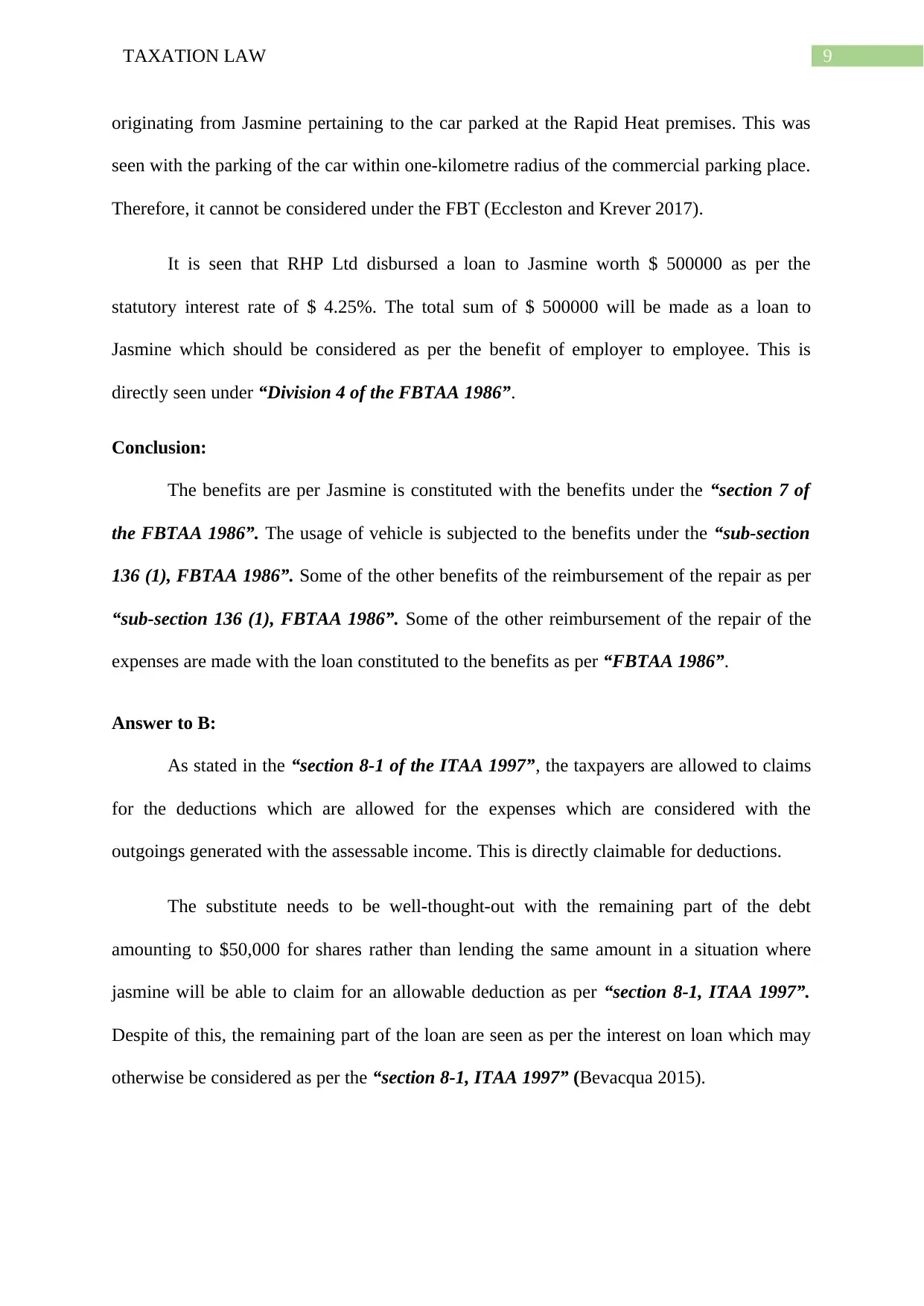
9TAXATION LAW
originating from Jasmine pertaining to the car parked at the Rapid Heat premises. This was
seen with the parking of the car within one-kilometre radius of the commercial parking place.
Therefore, it cannot be considered under the FBT (Eccleston and Krever 2017).
It is seen that RHP Ltd disbursed a loan to Jasmine worth $ 500000 as per the
statutory interest rate of $ 4.25%. The total sum of $ 500000 will be made as a loan to
Jasmine which should be considered as per the benefit of employer to employee. This is
directly seen under “Division 4 of the FBTAA 1986”.
Conclusion:
The benefits are per Jasmine is constituted with the benefits under the “section 7 of
the FBTAA 1986”. The usage of vehicle is subjected to the benefits under the “sub-section
136 (1), FBTAA 1986”. Some of the other benefits of the reimbursement of the repair as per
“sub-section 136 (1), FBTAA 1986”. Some of the other reimbursement of the repair of the
expenses are made with the loan constituted to the benefits as per “FBTAA 1986”.
Answer to B:
As stated in the “section 8-1 of the ITAA 1997”, the taxpayers are allowed to claims
for the deductions which are allowed for the expenses which are considered with the
outgoings generated with the assessable income. This is directly claimable for deductions.
The substitute needs to be well-thought-out with the remaining part of the debt
amounting to $50,000 for shares rather than lending the same amount in a situation where
jasmine will be able to claim for an allowable deduction as per “section 8-1, ITAA 1997”.
Despite of this, the remaining part of the loan are seen as per the interest on loan which may
otherwise be considered as per the “section 8-1, ITAA 1997” (Bevacqua 2015).
originating from Jasmine pertaining to the car parked at the Rapid Heat premises. This was
seen with the parking of the car within one-kilometre radius of the commercial parking place.
Therefore, it cannot be considered under the FBT (Eccleston and Krever 2017).
It is seen that RHP Ltd disbursed a loan to Jasmine worth $ 500000 as per the
statutory interest rate of $ 4.25%. The total sum of $ 500000 will be made as a loan to
Jasmine which should be considered as per the benefit of employer to employee. This is
directly seen under “Division 4 of the FBTAA 1986”.
Conclusion:
The benefits are per Jasmine is constituted with the benefits under the “section 7 of
the FBTAA 1986”. The usage of vehicle is subjected to the benefits under the “sub-section
136 (1), FBTAA 1986”. Some of the other benefits of the reimbursement of the repair as per
“sub-section 136 (1), FBTAA 1986”. Some of the other reimbursement of the repair of the
expenses are made with the loan constituted to the benefits as per “FBTAA 1986”.
Answer to B:
As stated in the “section 8-1 of the ITAA 1997”, the taxpayers are allowed to claims
for the deductions which are allowed for the expenses which are considered with the
outgoings generated with the assessable income. This is directly claimable for deductions.
The substitute needs to be well-thought-out with the remaining part of the debt
amounting to $50,000 for shares rather than lending the same amount in a situation where
jasmine will be able to claim for an allowable deduction as per “section 8-1, ITAA 1997”.
Despite of this, the remaining part of the loan are seen as per the interest on loan which may
otherwise be considered as per the “section 8-1, ITAA 1997” (Bevacqua 2015).
Paraphrase This Document
Need a fresh take? Get an instant paraphrase of this document with our AI Paraphraser
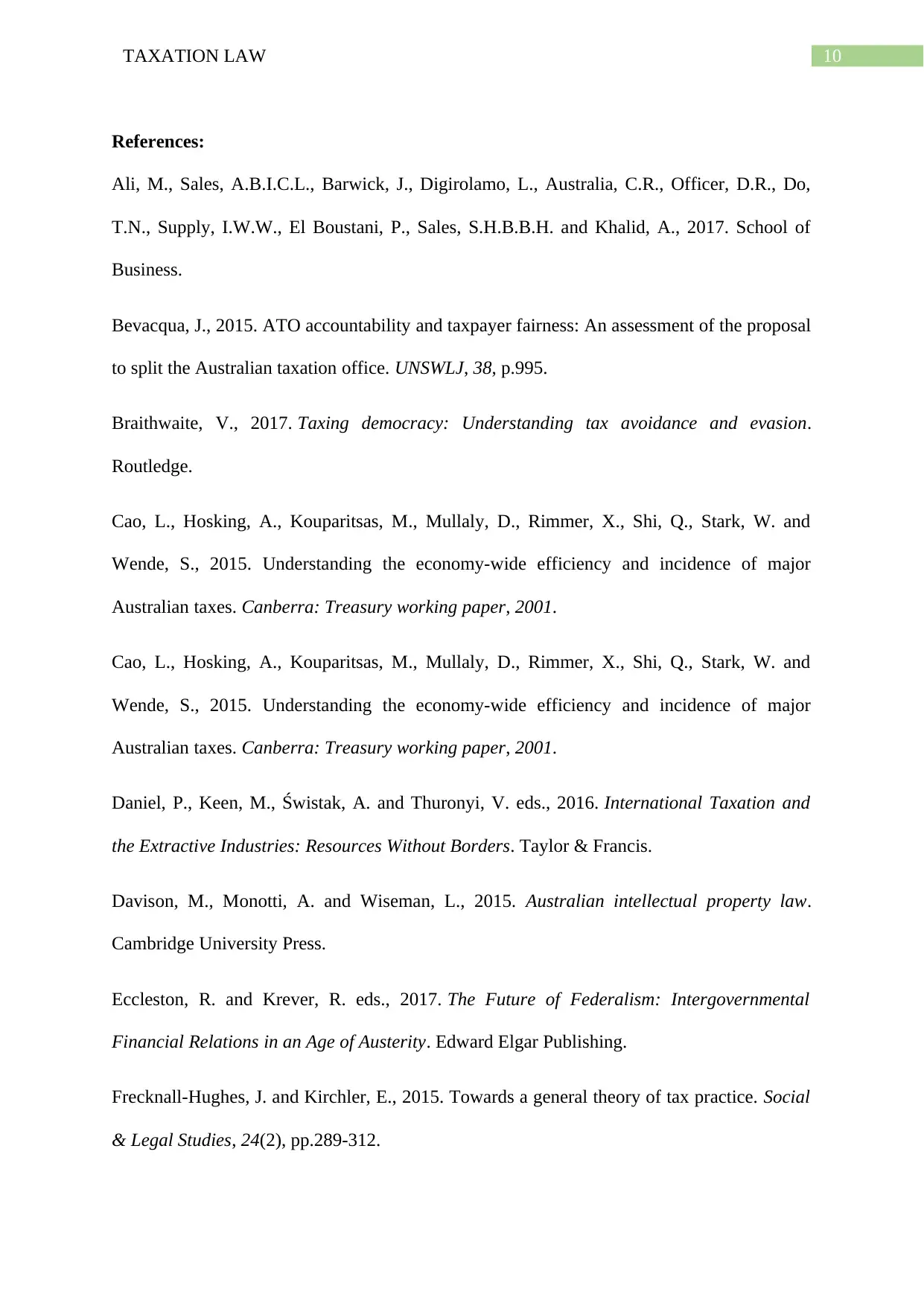
10TAXATION LAW
References:
Ali, M., Sales, A.B.I.C.L., Barwick, J., Digirolamo, L., Australia, C.R., Officer, D.R., Do,
T.N., Supply, I.W.W., El Boustani, P., Sales, S.H.B.B.H. and Khalid, A., 2017. School of
Business.
Bevacqua, J., 2015. ATO accountability and taxpayer fairness: An assessment of the proposal
to split the Australian taxation office. UNSWLJ, 38, p.995.
Braithwaite, V., 2017. Taxing democracy: Understanding tax avoidance and evasion.
Routledge.
Cao, L., Hosking, A., Kouparitsas, M., Mullaly, D., Rimmer, X., Shi, Q., Stark, W. and
Wende, S., 2015. Understanding the economy-wide efficiency and incidence of major
Australian taxes. Canberra: Treasury working paper, 2001.
Cao, L., Hosking, A., Kouparitsas, M., Mullaly, D., Rimmer, X., Shi, Q., Stark, W. and
Wende, S., 2015. Understanding the economy-wide efficiency and incidence of major
Australian taxes. Canberra: Treasury working paper, 2001.
Daniel, P., Keen, M., Świstak, A. and Thuronyi, V. eds., 2016. International Taxation and
the Extractive Industries: Resources Without Borders. Taylor & Francis.
Davison, M., Monotti, A. and Wiseman, L., 2015. Australian intellectual property law.
Cambridge University Press.
Eccleston, R. and Krever, R. eds., 2017. The Future of Federalism: Intergovernmental
Financial Relations in an Age of Austerity. Edward Elgar Publishing.
Frecknall-Hughes, J. and Kirchler, E., 2015. Towards a general theory of tax practice. Social
& Legal Studies, 24(2), pp.289-312.
References:
Ali, M., Sales, A.B.I.C.L., Barwick, J., Digirolamo, L., Australia, C.R., Officer, D.R., Do,
T.N., Supply, I.W.W., El Boustani, P., Sales, S.H.B.B.H. and Khalid, A., 2017. School of
Business.
Bevacqua, J., 2015. ATO accountability and taxpayer fairness: An assessment of the proposal
to split the Australian taxation office. UNSWLJ, 38, p.995.
Braithwaite, V., 2017. Taxing democracy: Understanding tax avoidance and evasion.
Routledge.
Cao, L., Hosking, A., Kouparitsas, M., Mullaly, D., Rimmer, X., Shi, Q., Stark, W. and
Wende, S., 2015. Understanding the economy-wide efficiency and incidence of major
Australian taxes. Canberra: Treasury working paper, 2001.
Cao, L., Hosking, A., Kouparitsas, M., Mullaly, D., Rimmer, X., Shi, Q., Stark, W. and
Wende, S., 2015. Understanding the economy-wide efficiency and incidence of major
Australian taxes. Canberra: Treasury working paper, 2001.
Daniel, P., Keen, M., Świstak, A. and Thuronyi, V. eds., 2016. International Taxation and
the Extractive Industries: Resources Without Borders. Taylor & Francis.
Davison, M., Monotti, A. and Wiseman, L., 2015. Australian intellectual property law.
Cambridge University Press.
Eccleston, R. and Krever, R. eds., 2017. The Future of Federalism: Intergovernmental
Financial Relations in an Age of Austerity. Edward Elgar Publishing.
Frecknall-Hughes, J. and Kirchler, E., 2015. Towards a general theory of tax practice. Social
& Legal Studies, 24(2), pp.289-312.
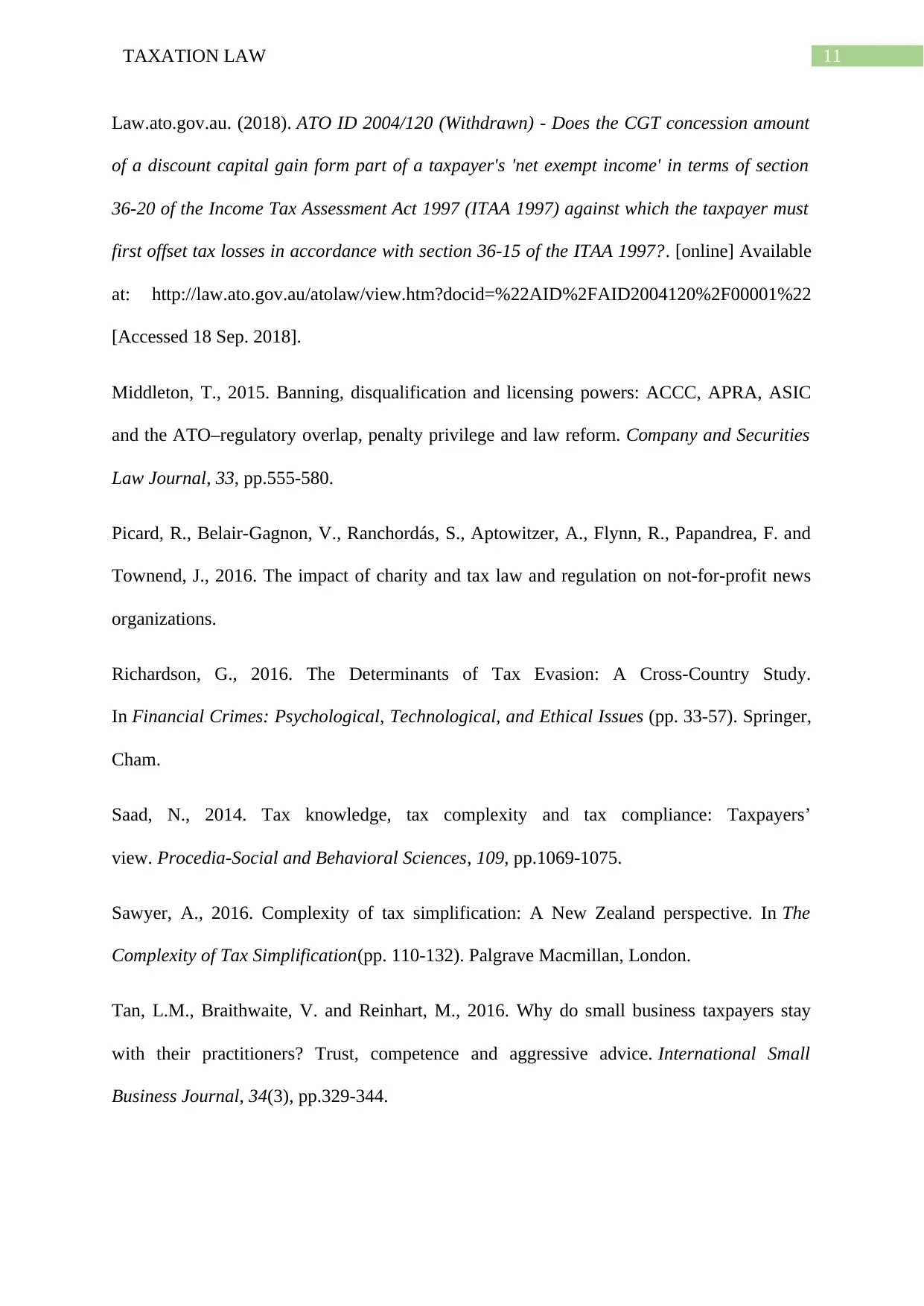
11TAXATION LAW
Law.ato.gov.au. (2018). ATO ID 2004/120 (Withdrawn) - Does the CGT concession amount
of a discount capital gain form part of a taxpayer's 'net exempt income' in terms of section
36-20 of the Income Tax Assessment Act 1997 (ITAA 1997) against which the taxpayer must
first offset tax losses in accordance with section 36-15 of the ITAA 1997?. [online] Available
at: http://law.ato.gov.au/atolaw/view.htm?docid=%22AID%2FAID2004120%2F00001%22
[Accessed 18 Sep. 2018].
Middleton, T., 2015. Banning, disqualification and licensing powers: ACCC, APRA, ASIC
and the ATO–regulatory overlap, penalty privilege and law reform. Company and Securities
Law Journal, 33, pp.555-580.
Picard, R., Belair-Gagnon, V., Ranchordás, S., Aptowitzer, A., Flynn, R., Papandrea, F. and
Townend, J., 2016. The impact of charity and tax law and regulation on not-for-profit news
organizations.
Richardson, G., 2016. The Determinants of Tax Evasion: A Cross-Country Study.
In Financial Crimes: Psychological, Technological, and Ethical Issues (pp. 33-57). Springer,
Cham.
Saad, N., 2014. Tax knowledge, tax complexity and tax compliance: Taxpayers’
view. Procedia-Social and Behavioral Sciences, 109, pp.1069-1075.
Sawyer, A., 2016. Complexity of tax simplification: A New Zealand perspective. In The
Complexity of Tax Simplification(pp. 110-132). Palgrave Macmillan, London.
Tan, L.M., Braithwaite, V. and Reinhart, M., 2016. Why do small business taxpayers stay
with their practitioners? Trust, competence and aggressive advice. International Small
Business Journal, 34(3), pp.329-344.
Law.ato.gov.au. (2018). ATO ID 2004/120 (Withdrawn) - Does the CGT concession amount
of a discount capital gain form part of a taxpayer's 'net exempt income' in terms of section
36-20 of the Income Tax Assessment Act 1997 (ITAA 1997) against which the taxpayer must
first offset tax losses in accordance with section 36-15 of the ITAA 1997?. [online] Available
at: http://law.ato.gov.au/atolaw/view.htm?docid=%22AID%2FAID2004120%2F00001%22
[Accessed 18 Sep. 2018].
Middleton, T., 2015. Banning, disqualification and licensing powers: ACCC, APRA, ASIC
and the ATO–regulatory overlap, penalty privilege and law reform. Company and Securities
Law Journal, 33, pp.555-580.
Picard, R., Belair-Gagnon, V., Ranchordás, S., Aptowitzer, A., Flynn, R., Papandrea, F. and
Townend, J., 2016. The impact of charity and tax law and regulation on not-for-profit news
organizations.
Richardson, G., 2016. The Determinants of Tax Evasion: A Cross-Country Study.
In Financial Crimes: Psychological, Technological, and Ethical Issues (pp. 33-57). Springer,
Cham.
Saad, N., 2014. Tax knowledge, tax complexity and tax compliance: Taxpayers’
view. Procedia-Social and Behavioral Sciences, 109, pp.1069-1075.
Sawyer, A., 2016. Complexity of tax simplification: A New Zealand perspective. In The
Complexity of Tax Simplification(pp. 110-132). Palgrave Macmillan, London.
Tan, L.M., Braithwaite, V. and Reinhart, M., 2016. Why do small business taxpayers stay
with their practitioners? Trust, competence and aggressive advice. International Small
Business Journal, 34(3), pp.329-344.
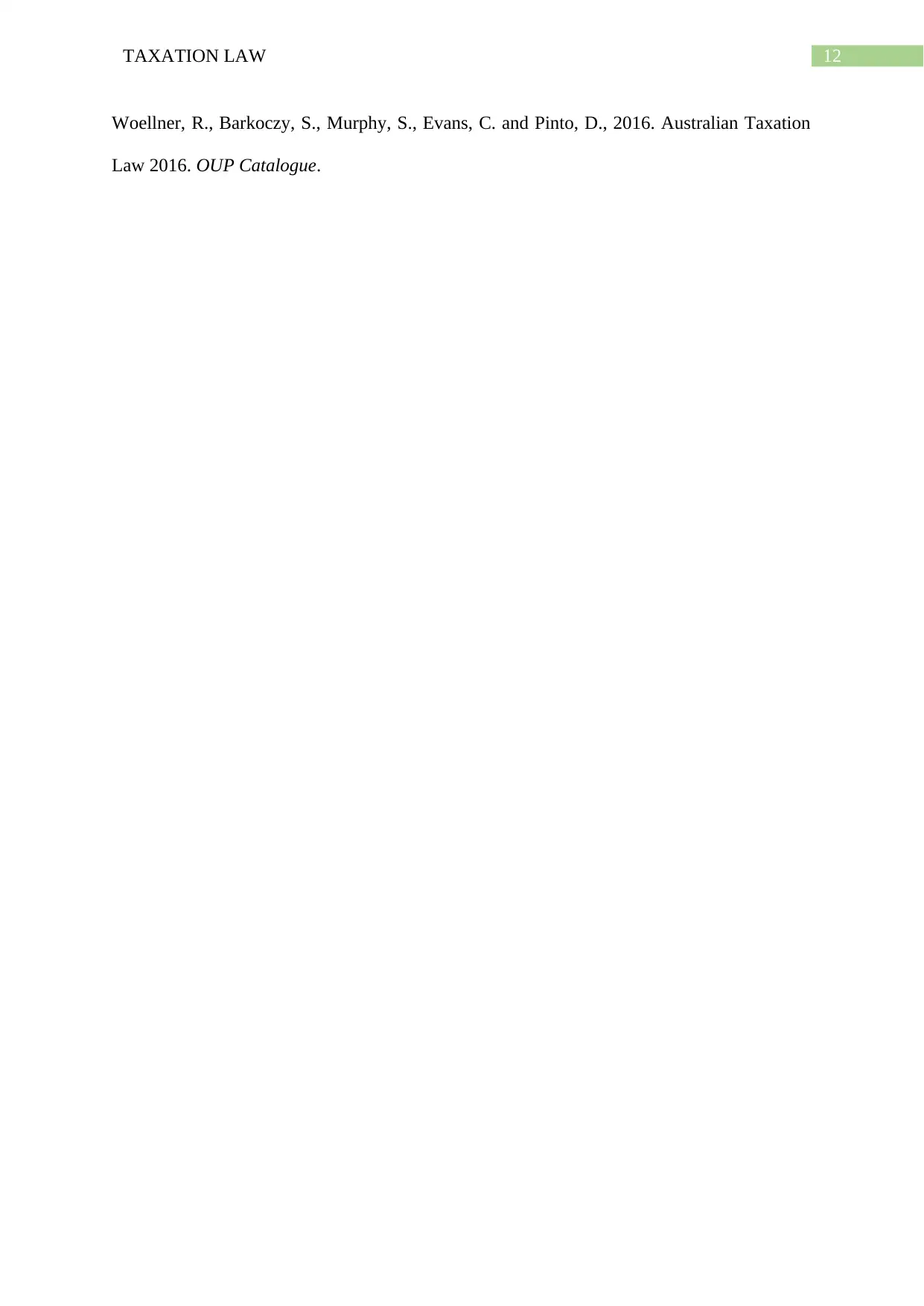
12TAXATION LAW
Woellner, R., Barkoczy, S., Murphy, S., Evans, C. and Pinto, D., 2016. Australian Taxation
Law 2016. OUP Catalogue.
Woellner, R., Barkoczy, S., Murphy, S., Evans, C. and Pinto, D., 2016. Australian Taxation
Law 2016. OUP Catalogue.
1 out of 13
![[object Object]](/_next/static/media/star-bottom.7253800d.svg)



